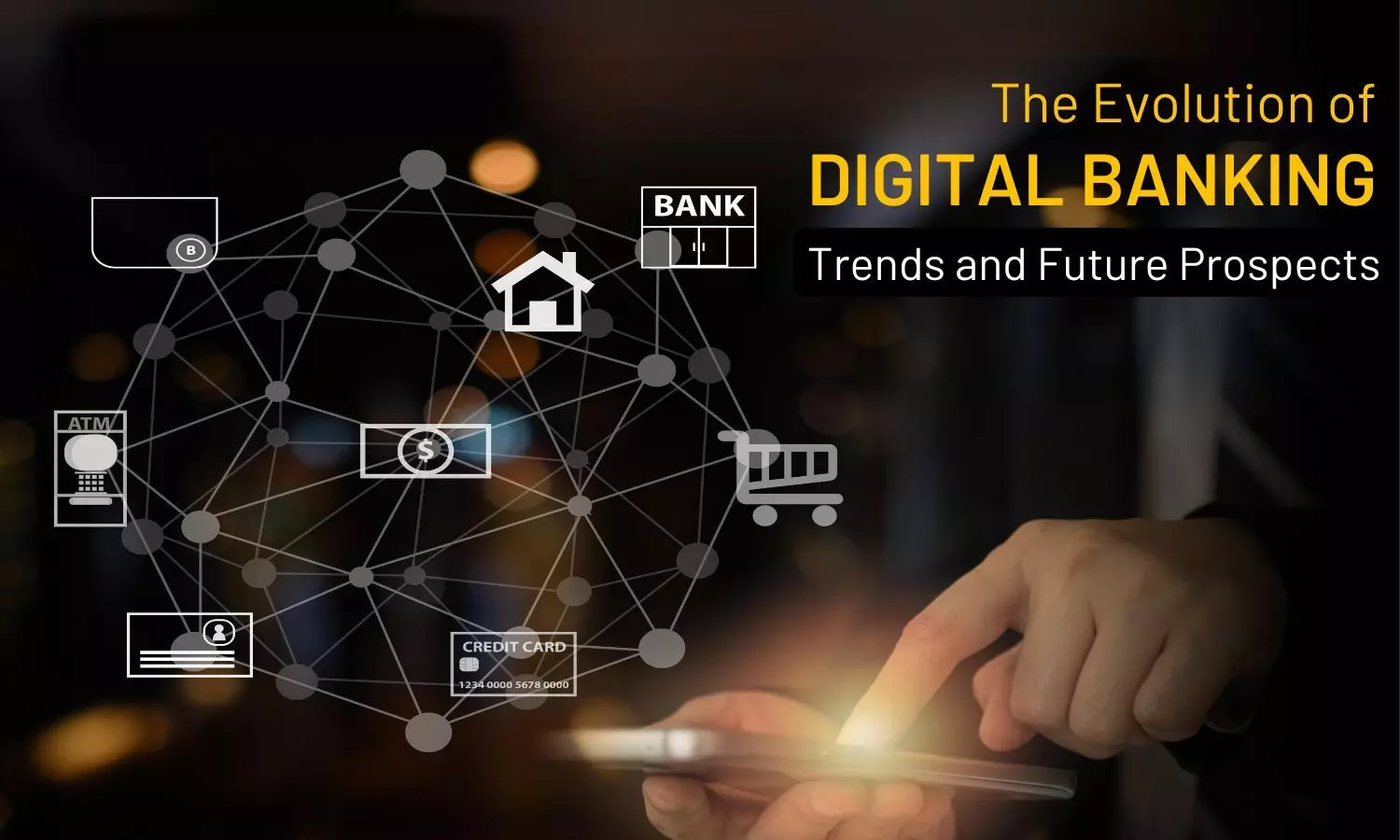The Rise of Digital Banking and Future Prospects
Diving into the evolution of digital banking, discussing key trends and ongoing advancements that are going to shape the banking experience.
The Rise of Digital Banking and Future Prospects

The global banking industry thrived with the introduction of digital banking. In India, electronic fund transfers become as simple as the UPI (Unified Payments Interface). Today, the preference for convenient, secure, and efficient banking is at an all time high. Digital banking is at the heart of this banking evolution offering sheer convenience and banking facilities via websites and mobile applications.
It dates back to the 1990s when the concept of digital banking saw light with the advent of the internet, which allowed banks to offer online services to their customers. Initially, these services were limited to basic functionalities such as checking account balances and transferring funds. However, as technology advanced, the scope of online banking also expanded to include more complex transactions like loan applications, recurring bill payments, and investment management.
The introduction of smartphones further accelerated the shift towards digital banking as mobile banking apps made it possible for customers to manage their finances from anywhere, thus enhancing the overall customer experience in banking. This convenience has driven the widespread adoption of digital banking, making it a standard service offering for banks worldwide.
Let’s have a look at some key trends in digital banking
The world of Fintechs: The rise of fintech companies has been a game-changer for the banking industry. Fintechs are leveraging technology to offer innovative financial solutions, from peer-to-peer lending and digital wallets to robo-advisors and blockchain-based services. The integration of fintech into traditional banking systems has led to the development of new banking solutions that are more efficient, customer-centric, and cost-effective.
The rise of Neobanks: Neobanks, also known as digital-only banks, have emerged as a significant trend in the banking sector. These are online-only banks offering a wide range of digital banking services to new age customers through mobile apps and websites. Neobanks are gaining popularity due to their low fees, user-friendly interfaces, and innovative features. Their growth signifies a shift towards a more digital and less branch-dependent banking model.
Digital banking platforms: The adoption of digital payment systems has revolutionised how transactions are conducted. Digital wallets and contactless payments have become the norm, offering customers a quick, secure, and convenient way to make payments. The demand for seamless payment experiences is driving banks to innovate and integrate new technologies into their digital banking platforms.
Blockchain in Banking: Blockchain technology is making significant inroads into the banking industry. Its decentralised and transparent feature offers numerous benefits, including enhanced security, reduced fraud, and improved efficiency in cross-border transactions. Banks are exploring the use of blockchain for various applications, such as smart contracts, digital identity verification, and real-time settlement systems.
Cloud banking: Technological advancements are at the heart of the digital banking evolution. Innovations such as AI in banking, machine learning, and data analytics are being used to personalise customer experiences, detect fraudulent activities, and optimise operations. In banking, automation is streamlining processes, reducing costs, and improving efficiency. Additionally, cloud banking is enabling banks to store and manage data securely while offering scalable and flexible solutions.
Advanced security: Cybersecurity threats such as hacking, phishing, and identity theft pose significant risks to banks and their customers. To combat these threats, banks are investing in advanced security technologies such as biometric authentication, encryption, and multi-factor authentication to strengthen digital banking security. Ensuring the safety and security of customer data is crucial for maintaining trust and compliance with regulatory standards.
Better Customer Experience: Enhancing the banking user experience has become a top priority for banks. Seamless, personalised, and convenient services has led to the development of intuitive banking apps and user-friendly interfaces. By leveraging data analytics and AI, banks can gain insights into customer behaviour and preferences, allowing them to tailor services and improve satisfaction
Future Prospects of Digital Banking
The future of banking lies in digitalisation. As more customers prefer online and mobile banking, traditional banks will continue to expand their digital offerings. Digital banking growth is expected to rise, with banks investing heavily in technology to stay competitive and meet evolving customer needs.
The rise of neobanks and virtual banking is set to continue, offering customers more choices and flexibility in managing their finances. These digital-only banks will challenge traditional banks, pushing them to innovate and improve their services to remain relevant.
Blockchain in banking will play a more prominent role, with banks adopting the technology for various applications, including secure transactions, smart contracts, and decentralized finance (DeFi). The integration of cryptocurrencies into mainstream banking services will also become more common as digital currencies gain acceptance.
The focus on enhancing the customer experience in banking will intensify, with banks using AI, data analytics, and machine learning to offer highly personalized services. Tailoring products and services to individual customer needs will be key to building loyalty and retaining customers in a competitive market.
As digital banking evolves, ensuring compliance with regulatory standards will be crucial. Banks will need to navigate complex regulations related to data privacy, cybersecurity, and anti-money laundering (AML) to maintain trust and avoid penalties. Digital banking security will continue to be a top priority, with banks investing in advanced technologies to protect customer data and transactions.
The future will see the emergence of new technologies that will further revolutionise the banking industry. Future banking technologies such as quantum computing, augmented reality (AR), and the Internet of Things (IoT) are likely to create new opportunities for banks to enhance customer experiences and develop innovative services.
Conclusion
The evolution of digital banking is reshaping the financial industry, offering customers more convenience, efficiency, and choice. Latest technologies and strategic innovations are creating growing demands for digital services in the fields of banking and investments. The future of banking is anticipated to be more digital, leaving minimum room for physical visits to banks.

